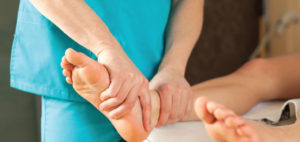 Every year more than a million patients visit their doctor due to heel pain! The most common foot and heel discomfort is caused by a painful disorder known as plantar fasciitis.
Every year more than a million patients visit their doctor due to heel pain! The most common foot and heel discomfort is caused by a painful disorder known as plantar fasciitis.
What is plantar fasciitis?
The foot is comprised of many different bones, joints, tendons, and ligaments; these include the plantar fascia. The plantar fascia is a band of ligament tissue. It stretches from the heel of your foot to the middle, and it is responsible for reinforcing and supporting your arch. When this area becomes inflamed due to extreme tension on the ligament, pain erupts every time you take a step, and if left untreated, many people will even experience discomfort while at rest.
Because plantar fasciitis is one of the most common foot issues; one in ten people will experience it at some time in their life. Usually, the pain is concentrated in the heel area, and it is generally caused by small injuries that occur over an extended period of time. It’s quite common for heel spurs, which are bony protrusions under the heel bone to coincide with plantar fasciitis.
There are many treatment options that you can do at home with the guidance of your podiatrist to try and alleviate the painful symptoms of plantar fasciitis. But, because of weight bearing, this area of the foot, in particular, is challenging to heal on its own. The key to getting your foot health back to normal and free from pain are to have medically based procedures provided by your podiatrist.
Education
The 1st key to successful treatment is education. The patient must understand why they aren’t getting better. We do our best to start there. So many soft tissue foot conditions such as plantar fasciitis are exacerbated or recreated with the first steps in the morning. That’s usually because the incompletely repaired tissue re-tears when the foot is not yet warmed up and ready to bear body weight. Think about when you go to the gym. You usually don’t and shouldn’t start exercising without warming up and stretching first. The foot is no different and needs to be treated as such. The body is able to do its greatest work while you’re at rest. In order to improve you must preserve what your body has healed. This is accomplished through targeted deep tissue manipulation that must be performed before putting pressure on your feet in the morning and any time you’ve been off your feet for extended durations of time. So helping the patient understand this and other issues alike improves outcome.
What are my Treatment options?
Targeted stretching is very effective, simple and doesn’t require medication, injection or surgery. Targeted stretching is instructed via video in our office. Seeing these special videos help the patient to understand exactly what they need to do and when. We usually will apply some type of strapping as well to affect better arch control and reduce tension to the plantar fascia. Most patients no matter how long they’ve had the problem will improve with these techniques.
When not sufficient, we immobilize with a walking boot. Complete resolution of pressure is good for just about every foot problem. Combining anti-inflammatory medication like Motrin, ibuprofen or other prescriptive meds is also helpful.
Laser Treatment
Laser therapy is one of the top methods to reduce your pain and inflammation. Deep tissue laser therapy uses a process called photobiomodulation, which penetrates deep into the muscles tissues using photon energy. This therapy increases cellular metabolism while decreasing inflammation and pain.
Injectables
When more invasive care is necessary, injections are available. Injection therapy has traditionally been performed with cortisone but in recent years prolotherapy has become more popular. This is a technique adopted from sports medicine.
Prolotherapy actually stimulates chronically injured tissue like the plantar fascia to heal on its own. During the injection process micro injury is elicited using a special technique and solution. Ultrasound is often used to help guide needle placement. More than one may be necessary and they’re usually separated by 6 weeks. Because micoinjury is created to the area of pain, the body is then forced to fix the injection site and the plantar fasciitis. During the 1st two weeks after prolotherapy injections patients are not permitted to use anti-inflammatories so as not to counter act the benefits of the injection. In other words, you want it to get inflamed and maybe a little more painful.
Whereas cortisone eliminates inflammation and pain, it is at the same time reducing or slowly healing. When used correctly it can be of benefit but it must be used with caution. Have you ever heard of the running back that had his knee injected with cortisone at half time only to come back in
the 2nd half with a spectacular performance? Wow! Cortisone is a miracle right. Then 3 months later he needs his knee reconstructed. No one talks about how the cortisone was likely responsible. Lots of patients come running back looking for another injection stating the cortisone “stopped working”. It never really worked. It only masked the symptoms until like the athlete the injury just got worse. The symptoms were masked by the effects of cortisone. I try to stay away from it if I can.
Stabilization
Once the patient gets better and the plantar fascia repairs itself we recommend orthotics. Orthotics are inserts which help to control abnormal foot function. Abnormal foot function is how many foot problems develop. Think of braces on teeth. They keep everything aligned. So too do the orthotics or inserts custom fabricated for a patient. When fabricated correctly should provide better alignment reducing recurrence of plantar fasciitis. Unfortunately all the above may fail requiring surgery.
Surgery
As a last resort surgery is sometimes necessary for patients having failed conservative care. It’s done arthroscopically through 1 or 2 small incisions. The surgery is very effective seeing almost %100 resolution of the problem. Patients are walking the same day in a walking boot and slowly over time see the painful condition resolve. Like a prolotherapy injection, it harnesses the body own inflammatory system.
At Home Care
It’s important to be examined by an experienced podiatric professional if you’re experiencing any foot pain.
Along with these treatment options, Mid Florida Foot, Ankle & Vein Clinic will provide you with personalized instructions on the necessary amount of rest, stretching exercises and home care to get you back to doing what you love.
Mid Florida Foot, Ankle & Vein Clinic provides pain-reducing, comprehensive, cutting-edge treatment. Their podiatrist, Dr. Gabriel Delgado, can treat all foot problems and even performs in-office surgeries. Rest assured you’ll get patient-focused care from their highly skilled and compassionate staff.
To find out more, or to schedule your appointment, please contact Mid Florida Foot, Ankle & Vein Clinic today.
Dr. Gabriel F Delgado FACFAS
Lakeland Office
203 Kerneywood St., Lakeland, FL 33803
Bartow Office
510 West Main St., Bartow, FL 33830
midflfootanklevein.com
863-686-1641
Check Also
I Have a Wait Problem
You’re reading a health and wellness magazine and you’re thinking: that guy can’t spell. But …
 Central Florida Health and Wellness Magazine Health and Wellness Articles of the Villages
Central Florida Health and Wellness Magazine Health and Wellness Articles of the Villages



